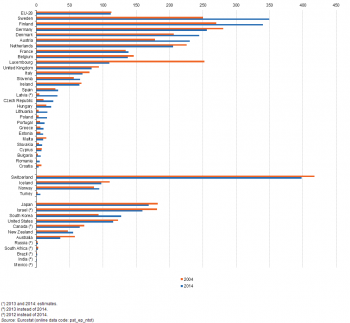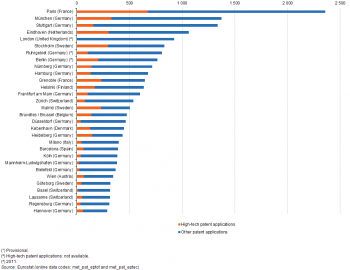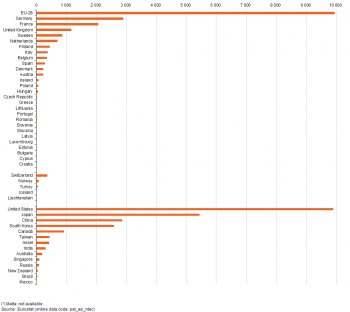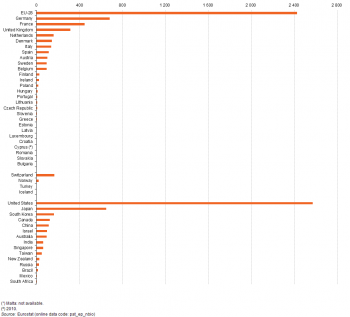Archive:Patent statistics
This Statistics Explained article is outdated and has been archived - for recent articles on Science, technology and digital society see here.
- Data extracted in October 2016. Most recent data: Further Eurostat information, Main tables and Database.

(per million inhabitants)
Source: Eurostat (pat_ep_ntot)

(number)
Source: Eurostat (met_pat_eptot) and (met_pat_eptec)

(number)
Source: Eurostat (pat_ep_ntec)

(number)
Source: Eurostat (pat_ep_nbio)

(number)
Source: Eurostat (pat_ep_nnano) and (pat_ep_nrns)

(number)
Source: Eurostat (pat_ep_nrg)
This article provides information on patent applications in the European Union (EU). Patents reflect inventive activity and they also show the capacity to exploit knowledge and translate it into potential economic gains. In this context, indicators based on patent statistics are widely used to assess the inventive performance of countries or regions. The grounds for the assumption that a patent represents a codification of inventive activity rely on the novelty, utility and inventiveness that an invention requires to be patented. On the basis of this assumption, Eurostat collects patent statistics to construct indicators of research and development (R & D) output.
Main statistical findings
The total number of patent applications to the European Patent Office (EPO) was 142.7 thousand in 2014. Applications from EU-28 Member States reached 56.6 thousand in 2014 (or 39.6 % of the total), an increase of 1.1 thousand compared with 2004, or a gain of 2.0 % in relative terms.
Analysis of patent applications from EU Member States and non-member countries
Among the EU Member States, Germany had by far the highest number of patent applications to the EPO in 2014, some 20.7 thousand (36.5 % of the EU-28 total), followed by France (9.1 thousand), the United Kingdom (5.3 thousand), Italy (4.2 thousand), the Netherlands (3.5 thousand) and Sweden (3.4 thousand). From non-member countries, the highest numbers of patent applications were recorded from the United States (36.8 thousand) and Japan (21.3 thousand), followed by China (7.5 thousand) and South Korea (6.4 thousand).
Relative to its population (see Figure 1), Sweden reported the highest number of patent applications in 2014, some 349 per million inhabitants, followed by Finland (340), Germany (256), Denmark (244), Austria (230) and the Netherlands (205). With the exception of Italy (70 patent applications per million inhabitants) and Slovenia (66), all of the southern and eastern EU Member States as well as the Baltic Member States reported less than 50 patent applications per million inhabitants in 2014.
Between 2004 and 2014 (between 2004 and 2013 for Latvia and Malta) the number of patent applications filed at the EPO fell for seven of the EU Member States. The largest contractions, in relative terms, were recorded for Croatia, Luxembourg, Malta and Germany and the largest, in absolute terms, for Germany, Italy, the United Kingdom and the Netherlands. The increases recorded for the remaining 21 Member States were highest, in absolute terms, for Sweden, France, Austria, Poland and Finland, while in relative terms the largest increases were recorded for Latvia (where applications were 6.5 times as high in 2013 as they had been in 2004), Poland, Romania, Lithuania (where applications were between three and four times as high in 2014 as they had been in 2004), Bulgaria, the Czech Republic, Slovakia and Portugal (where the number of applications was more than twice as high in 2014 as it had been in 2004).
Analysis for the top 30 metropolitan areas in the EU
Eurostat recently started to compile patent applications data by metropolitan areas, in other words a geographical analysis based on data for one or more NUTS level 3 regions. Seen from this different angle, unsurprisingly many capital city areas appear near the top of the 2012 ranking (see Figure 2), for example Paris, London, Stockholm, Berlin, Helsinki, Bruxelles/Brussel, København and Wien. The top 30 included 14 German metropolitan areas, with six of these in the top 10. In France, the traditionally high concentration of research centres in the metropolitan area of Paris is reflected through the 2 360 patent applications that were registered here, the highest number among all metropolitan areas of the EU; Grenoble was the only other French metropolitan area to appear in the top 30. Three metropolitan areas from each of Sweden and Switzerland ranked in the top 30, namely Stockholm, Malmö and Göteborg, and Zürich, Basel and Lausanne.
In 2012, high-technology patent applications represented 45.6 % of the total patent applications in Malmö and just over one third of all applications in Grenoble, Stockholm and Heidelberg (Germany); there is no breakdown available for London. By contrast, there were five of these top 30 metropolitan areas where high-technology patents accounted for less than 10 % of all patent applications: four of these were in Germany — Köln, Düsseldorf, Bielefeld and Mannheim-Ludwigshafen — while the lowest share was recorded in Basel (4.7 %).
Selected types of patents
Patent applications for information and communication technologies (ICT) represented almost one third (31.5 %) of the total applications made to the EPO in 2012. The relative share of the EU Member States in the number of ICT patents was quite low, as they accounted for 32.0 % of all ICT applications. ICT patent applications to the EPO were relatively concentrated in a small group of EU Member States. The highest numbers of ICT patent applications were recorded in Germany, France, the United Kingdom, Sweden, the Netherlands, Italy and Finland, all of which reported more than 500 applications (see Figure 3). Collectively, these seven Member States filed 87.2 % of the ICT patent applications made from within the EU-28 in 2012. The number of ICT patent applications from non-member countries was particularly high in the United States (11.9 thousand) and Japan (7.6 thousand), while China and South Korea each made a greater number of applications than any of the EU Member States apart from Germany.
High-technology patent applications accounted for slightly less than one quarter (23.9 %) of the applications made to the EPO in 2012. The EU Member States accounted for less than one third of these (29.2 %). The number of EU-28 high-technology patent applications stood at 10.0 thousand in 2012, with Germany, France and the United Kingdom the only EU Member States to report that they had made more than one thousand high-technology patent applications in 2012 (see Figure 4). The number of high-technology patent applications made to the EPO from the United States was almost level with the total from the EU-28, at 9.9 thousand, while there was a relatively high number of applications from Japan (5.4 thousand). China and South Korea both recorded between 2.5 and 3.0 thousand high-technology patent applications to the EPO, with only Germany (among the EU Member States) recording a higher number.
Biotechnology is a growing area of activity within the EU and this growth was reflected in the number of biotechnology patents (see Figure 5). In 2012, there were 6.8 thousand biotechnology patent applications, which equated to 4.8 % of the total number of applications made to the EPO. Of these, just over one third (35.6 %) or some 2.4 thousand were from the EU Member States (see Figure 5). A slightly higher number of biotechnology patent applications were filed with the EPO from the United States (2.6 thousand in 2012), while Japan (649) had slightly fewer applications than the number recorded in Germany (682).
Among emerging technologies, nanotechnology is one of the most prominent examples, and there are high expectations for the application of nanotechnologies in a wide range of areas affecting daily life. Nanotechnology can be present in almost any area of science and engineering: it is just as relevant to biotechnologists and physicists as it is to electrical and mechanical engineers or materials scientists. Based on the number of patent applications made to the EPO in 2012, nanotechnology was a field of research still in its infancy and therefore small in terms of patenting activity: there were 295 nanotechnology patent applications from the EU-28, equivalent to 0.5 % of all EU-28 patent applications (see Figure 6). The EU-28 accounted for 37.5 % of the total number of nanotechnology patent applications to the EPO, with the highest number being filed from France (73), followed by Germany (69), the United Kingdom (40) and the Netherlands (31). Among the non-member countries, the United States accounted for 29.1 % of all nanotechnology patent applications to the EPO, followed by Japan (14.8 %) and South Korea (5.7 %).
Figure 6 also shows the number of patent applications concerning radio navigation by satellite, for example related to the existing global positioning system (GPS) or the planned Galileo global satellite navigation system. There were 1 007 radio navigation by satellite patent applications to the EPO in 2012, of which 400 were filed from within the EU-28 (equivalent to 39.8 % of the total). The highest numbers of applications among the EU Member States were recorded in Germany (158) and France (68), followed by Sweden (34), Finland (33) and the United Kingdom (30). The United States (328 applications or 32.6 % of the total) and Japan (112 applications or 11.1 %) were the only non-member countries to account for more than one tenth of the total number of radio navigation by satellite patent applications to the EPO.
Patent applications for energy technologies
Figure 7 offers an overview of the number of patent applications in 2012 from within the EU-28 to the EPO concerning energy technologies. The strong predominance of patent applications related to wind energy (645), photovoltaic energy (334), solar thermal energy (221) is particularly notable, underlining the interest in harnessing energy from renewable sources; the same was true in relation to energy storage (257) and fuel cells (226). Energy storage is a key issue in the balance between demand for electricity and the sometimes intermittent supply of electricity from wind and solar power, while fuel cells are linked to power generation technologies (portable or stationary), or to the generation of power for transport (for example, in electric cars).
Data sources and availability
Since 2007, Eurostat’s production of data on patents has been based almost exclusively on the EPO’s worldwide statistical patent database (PATSTAT). The EPO grants European patents for the 38 contracting states to the European Patent Convention (or Munich Convention): the EU Member States, the EFTA Member States, some candidate countries (the former Yugoslav Republic of Macedonia, Serbia and Turkey), as well as Albania, Monaco and San Marino.
European patent applications refer to applications filed directly under the EPC or to applications filed under the Patent Cooperation Treaty (PCT) and designated to the EPO (Euro-PCT). Patents data are classified in accordance with the international patents classification of applications (IPC). Patent applications are counted according to the year in which they are filed and are assigned to a country according to the inventor’s place of residence, using fractional counting if there are multiple inventors for a single patent. They can be presented at a national or regional level; for the latter the data are aggregated by linking postcodes and/or place names to NUTS level 2 and 3 regions.
High-technology patents are counted following criteria established by the trilateral statistical report (drafted by the EPO, the United States Patent and Trademark Office (USPTO) and the Japan Patent Office (JPO)), where the following technical fields are defined as high-technology groups in accordance with the international patent classification (IPC): computer and automated business equipment; micro-organism and genetic engineering; aviation; communication technology; semiconductors; and lasers.
Due to legal rules imposed by the patent application process, information on patent applications is disclosed to the public 18 months or more after the priority date. As a result, the delay before indicators can be compiled can extend to more than five years depending on the computational method used to develop indicators. In order to overcome this issue, nowcasting methods have been developed.
Context
A patent is a legal title of industrial property granting its owner the exclusive right to exploit an invention commercially for a limited area and time. The patent confers on its owner the right to stop others from, among other things, copying, using or selling such invention without authorisation. In return for the exclusive right to exploit it, the technical details of the invention are published. Patentability requires novelty, inventiveness and industrial applicability of the invention.
Patents, as a legal instrument to protect invention, are strongly influenced by the legal system that surrounds them. The European patent framework, in particular, is rather complex, since national systems co-exist with the European patent, and a third system, the unitary patent. The unitary patent — or ‘European patent with unitary effect’ — is a European patent, granted by the EPO under the rules and procedures of the EPC, to which, upon request of the patent proprietor, unitary effect is given for the territory of the 25 EU Member States participating in the unitary patent scheme. Patent proprietors will in the future be able to choose between various combinations of classical European patents and unitary patents, for example:
- a unitary patent for the 25 Member States of the EU which participate in the unitary patent scheme;
together with
- a classical European patent taking effect in one or more EPC contracting states which do not participate in the scheme, such as Spain, Croatia, Italy, Iceland, Norway, Switzerland or Turkey.
Technological change and innovation have become two main areas of economic analysis in industrialised countries, as they are determining factors for productivity and competitiveness. Science and technology activities are crucial for fostering technical innovation, and therefore there is an increasing interest for describing science and technology activities in both quantitative and qualitative terms. In this context, science and technology activities are mainly measured by using indirect input, output and impact indicators: patent data are used in the context of output indicators. In particular, indicators based on patents can be of use for assessing the performance of application-oriented types of research and development, although patents do not cover all kinds of innovation activity. As such, patent indicators are often complemented by other science and technology indicators, so as to obtain a more complete view of innovation activities.
See also
- Innovation and information society statistics introduced
- Innovation statistics
- Patent statistics background
Further Eurostat information
Publications
- Science, technology and innovation in Europe — 2013 edition (Pocketbook)
- Science, technology and innovation in Europe — 2012 edition (Pocketbook)
Main tables
- Science and technology, see:
- Intellectual property rights (t_ipr)
- Patent (t_pat)
- Patent applications to the European patent office (EPO) by priority year (tsc00009)
- High-tech patent applications to the European patent office (EPO) by priority (tsc00010)
- Patent applications to the European patent office (EPO) by priority year by NUTS 2 regions (tgs00040)
- High-tech patent applications to the European patent office (EPO) by priority year by NUTS 2 regions (tgs00041)
- Patents granted by the United States patent and trademark office (USPTO) by priority year (tsc00033)
- Patent (t_pat)
Database
- Science and technology, see:
- Intellectual property rights (ipr)
- Patent (pat)
- Patent applications to the European patent office (EPO) by priority year (pat_epo)
- Patents granted by the United States patent and trademark office (USPTO) by priority year (pat_uspto)
- Triadic patent families by earliest priority year at the national level (pat_triadic)
- Patent (pat)
Dedicated section
Methodology / Metadata
- Patent statistics (ESMS metadata file — pat_esms)
- Patent Statistics — Working Paper: Methods for Nowcasting Patent Data
- Patent statistics at Eurostat: Mapping the contribution of SMEs in EU patenting — 2014 edition
Source data for tables and figures (MS Excel)
Other information
- Patent Statistics at Eurostat: Part 1 Methods for Regionalisation
- Patent Statistics at Eurostat: Part 2 Sector Allocation
- Patent Statistics at Eurostat: Part 3 Name Harmonisation
External links
- European Commission — Directorate-General for Internal Market, Industry, Entrepreneurship and SMEs — Intellectual property — Patent
- European Patent Office (EPO) — Statistics
- Japan Patent Office (JPO)
- Korean Intellectual Property Office (KIPO)
- OECD Patent Statistics Manual
- PATSTAT — the EPO Worldwide Patent Statistical Database (Information flyer)
- The Organisation for Economic Co-operation and Development (OECD)
- Unified Patent Court
- Unitary patent
- US National Science Foundation (NSF)
- US Patent and Trademark Office (USPTO)
- World Intellectual Property Organisation (WIPO)
